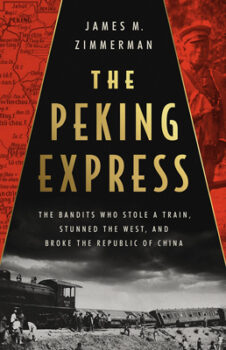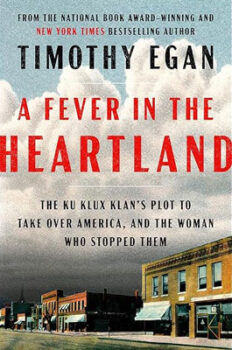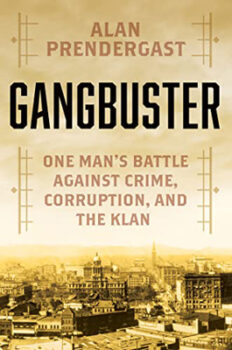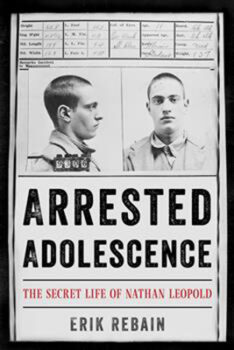Stranger Than Fiction
October 2023
Crimes of a Century (Ago)
by Dean Jobb
The brutal Indiana murder that brought down a powerful leader of the Ku Klux Klan, a crusading district attorney who battled the Klan in Colorado, China’s Great Train Robbery, and a fresh look at the life of a Chicago murderer who killed for the thrill of it. A roundup of recent books that revisit true crime in the rollicking, anything-goes Jazz Age.
 It’s likely the most spectacular and significant train robbery you’ve never heard of. In May 1923 an army of bandits derailed and looted an express running from Shanghai to Peking and kidnapped more than a hundred of the passengers. The foreign travelers and businessmen taken hostage included an Italian lawyer who supported Mussolini, the publisher and Chicago Tribune correspondent John B. Powell, and Lucy Aldrich, the sister-in-law of Standard Oil founder John D. Rockefeller. Along with abductees from an array of other countries, they became the focus of a weeks-long drama that played out in the international press.
It’s likely the most spectacular and significant train robbery you’ve never heard of. In May 1923 an army of bandits derailed and looted an express running from Shanghai to Peking and kidnapped more than a hundred of the passengers. The foreign travelers and businessmen taken hostage included an Italian lawyer who supported Mussolini, the publisher and Chicago Tribune correspondent John B. Powell, and Lucy Aldrich, the sister-in-law of Standard Oil founder John D. Rockefeller. Along with abductees from an array of other countries, they became the focus of a weeks-long drama that played out in the international press.
James M. Zimmerman, a Beijing-based lawyer and first-time author, tells this Wild West-meets-Far East story in The Peking Express: The Bandits Who Stole a Train, Stunned the West, and Broke the Republic of China (PublicAffairs). It’s a remarkable tale told in you-are-there detail thanks to Zimmerman’s deep research. He amassed a trove of press coverage, collected hostages’ accounts of their ordeal and records held by their descendants, and consulted archives in China, the U.S, and Britain.
The passengers became pawns in a power struggle between bandit chief Sun Mei-yao and a Chinese government that was struggling to control a country mired in the past—American Roy Scott Anderson, a local fixer who would help defuse the crisis, described China as “comparable to Europe at the close of the Middle Ages.” Sun commanded a private army of disgruntled former soldiers that terrorized and robbed peasants who had little food and few belongings to plunder. The modern, luxurious Peking Express, a symbol of China’s attempt to leap into the twentieth century, was a tempting target.
The train was attacked at night and the hostages, most of them still in their nightclothes and barefoot, were force-marched to the bandits’ mountain hideouts. There was little food. Shelter was primitive (Aldrich spent one night sleeping on straw inside a hovel she suspected was used as a dog house). Gunmen executed Chinese passengers who failed to keep up as government troops pursued the kidnappers into the hills.
Zimmerman, who has practiced law in China for more than a quarter-century, is an expert guide to the history and geopolitics at the heart of this story (and to the human story as well—during his research he visited many of the locations where the story unfolded). An international effort was mounted to free the hostages, leading to tense negotiations for their release. Did they survive weeks in captivity? Did the Chinese government recover from the blow to its authority and prestige? For the answers, check out this absorbing account of a forgotten, high-stakes heist that inspired a Hollywood movie and changed the course of history.
 A Fever in the Heartland: The Ku Klux Klan’s Plot to Take Over America, and the Woman Who Stopped Them (Viking) is a hard book to read. This has nothing to do with the writing. New York Times bestselling author Timothy Egan has won a Pulitzer Prize, a National Book Award, and the Andrew Carnegie Medal for Excellence in Nonfiction, and this fast-paced, absorbing tale showcases his mastery of storytelling. It’s his subject—a nightmarish, all-too-familiar America where democracy is under siege and politicians spouting hate are polluting the public sphere and warping minds.
A Fever in the Heartland: The Ku Klux Klan’s Plot to Take Over America, and the Woman Who Stopped Them (Viking) is a hard book to read. This has nothing to do with the writing. New York Times bestselling author Timothy Egan has won a Pulitzer Prize, a National Book Award, and the Andrew Carnegie Medal for Excellence in Nonfiction, and this fast-paced, absorbing tale showcases his mastery of storytelling. It’s his subject—a nightmarish, all-too-familiar America where democracy is under siege and politicians spouting hate are polluting the public sphere and warping minds.
The fever was the resurgence of the Ku Klux Klan in the early 1920s. The heartland was Indiana, the state that boasted the largest Klan membership in the nation. The northward expansion of a terrorist group that emerged in the Deep South after the Civil War was largely the work of one man, David C. Stephenson, an odious character who combined a con man’s slickness with a lust for wealth and power that was worthy of a mob boss. One of the phones on his desk, he claimed, was a direct line to the Oval Office. “Charm,” Egan notes in a memorable phrase, “oozed from him like grease from a sizzling sausage.”
The self-proclaimed Invisible Empire was all too visible during the Roaring Twenties, with its cartoonishly hooded adherents marching in parades and posing for newspaper photographs alongside politicians and Protestant clergymen. There were Klanswomen and, perhaps most disturbingly, Ku Klux Kiddies to ensure there would be future generations of white supremacists. It spread to Colorado, California, Oregon and other states and claimed millions of members. Supporters burned crosses and terrorized Blacks, Jews, Catholics, and immigrants. Members and fellow-travelers too intimidated or corrupt to resist the KKK steamroller included Congressmen, governors and state legislators, judges, police officers, and newspaper editors.
Stephenson catapulted himself into the Klan’s leadership as Indiana’s Grand Dragon. It was, as Egan reveals, supposed to be a stepping-stone to a run for the presidency in 1928. For Stephenson, however, promoting hatred was a means to an end—and the end was the enrichment of the Grand Dragon. He skimmed money off membership fees and the sale of hoods and robes. He bought a mansion and a yacht. He was a sexual predator, a drunk, a serial rapist and a serial liar. He thought he was above the law, and had enough Klan connections and bribe money to keep out of jail. But his debauched lifestyle caught up with him when he raped and battered a young woman named Madge Oberholtzer. Her dying declaration threatened to put him in prison and bring down the Klan. “I am the law,” Stephenson had told her, a boast put to the test in a courtroom as the book hurtles toward its satisfying conclusion.
 Colorado was another hotbed of Klan activity in the 1920s and the organization’s assault on democracy in that state ran head-on into Denver’s version of Eliot Ness—a relentless, incorruptible district attorney named Philip Van Cise. A veteran of the Great War, he campaigned for the office of the city’s top prosecutor in 1920 on the slogan, “A Fighting Man For a Fighting Job,” and was soon plotting military-style campaigns against organized crime, corrupt cops and politicians, and the Klan.
Colorado was another hotbed of Klan activity in the 1920s and the organization’s assault on democracy in that state ran head-on into Denver’s version of Eliot Ness—a relentless, incorruptible district attorney named Philip Van Cise. A veteran of the Great War, he campaigned for the office of the city’s top prosecutor in 1920 on the slogan, “A Fighting Man For a Fighting Job,” and was soon plotting military-style campaigns against organized crime, corrupt cops and politicians, and the Klan.
Journalist and true-crime author Alan Prendergast tackles the story of this little-known crimefighter in Gangbuster: One Man’s Battle Against Crime, Corruption, and the Klan (Citadel), an engaging account of Van Cise’s major investigations that hooks readers with the twists and turns of a police procedural. With corruption widespread within the Denver police and the DA’s office, Van Cise formed his own version of the Untouchables—a band of handpicked lawyers and detectives recruited from other cities. He appealed to wealthy citizens for donations to fund his probes, and some even supplied their cars and chauffeurs to transport prisoners.
The DA’s first coup was nabbing a mob of swindlers, led by Denver hoodlum Lou “The Fixer” Blonger, that used the city as a base to rope in and fleece unwary investors. The press dubbed them the “Tricky Twenty.” Van Cise employed an early bugging device to gather evidence and Blonger’s overheard boasts and snide remarks are highlights of the book. His next challenge was the KKK. “We will not stand for any Ku Klux Klan monkey business in Denver,” he declared when a Black man received death threats in 1922.
Thousands bought memberships—people itching to pay “ten dollars each to hate somebody,” as one Colorado critic put it. Grand Dragon John Galen Locke, a gun-toting drunkard and homeopathic doctor, built a statewide organization second in size only to Stephenson’s Indiana Klan. There were racially motivated kidnappings, beatings, and threats. A Klan member was elected mayor of Denver, another became governor. It fell to Van Cise to lead the battle against this juggernaut of hate. His personal courage and refusal to back down, despite an odious campaign of lies, harassment, and threats of violence, was astounding. The Colorado Klan ultimately self-destructed, the victim of infighting and its own extremist dogma, but Prendergast gives Van Cise the credit he deserves as not only a gangbuster, but as a Klan-buster.
 Nathan Leopold had it made in the summer of 1924. The studious nineteen-year-old was the pampered youngest child of a wealthy and prominent Chicago family. He had graduated from high school at fifteen and had been accepted at Harvard Law School. Then the unthinkable happened—he teamed up with Richard Loeb, another wealthy young over-achiever, to abduct and kill a younger neighbor, Bobby Franks, just to prove they could get away with murder. They almost did. The “thrill-killing” shocked America and earned the overused title of Crime of the Century.
Nathan Leopold had it made in the summer of 1924. The studious nineteen-year-old was the pampered youngest child of a wealthy and prominent Chicago family. He had graduated from high school at fifteen and had been accepted at Harvard Law School. Then the unthinkable happened—he teamed up with Richard Loeb, another wealthy young over-achiever, to abduct and kill a younger neighbor, Bobby Franks, just to prove they could get away with murder. They almost did. The “thrill-killing” shocked America and earned the overused title of Crime of the Century.
The case has been the subject of movies, documentaries, and numerous books. Erik Rebain, an archivist for the Chicago Tribune and Chicago History Museum, weighs in with a new, deeply researched biography of one-half of the infamous duo. Arrested Adolescence: The Secret Life of Nathan Leopold (Rowman & Littlefield) is the product of a decade of research and Rebain was in his element as he scoured dozens of archives for fresh material unseen for a century.
Not surprisingly, his subject emerges as a cold, selfish, egotistical, and thoroughly detestable human being. “Ever since I can remember,” Leopold once said, “I have heard how bright I was.” He grew up believing he was superior, a disturbed loner who began to act out his twisted sexual fantasies. He was, Rebain writes, “a dangerous mix of arrogance and insecurity.” In 1920 he became friends with Loeb, a kindred spirit who had also skipped grades and attended college at a young age. Loeb pulled petty thefts for kicks and introduced Leopold to his hobby. They became lovers as well as inseparable. Their toxic relationship culminated in a cold-blooded murder, guilty pleas, and a sensational courtroom battle to determine whether they would be hanged, with famed attorney Clarence Darrow arguing—successfully—that their lives be spared.
Rebain sifts through the reports of the many prosecution and defence psychiatrists who struggled to understand why they did it. The findings and Leopold’s aloofness pegged him as a psychopath with zero empathy for others and no remorse for killing Franks. “Making up my mind to commit murder was practically the same as making up my mind whether or not I should eat pie for supper,” he said, “whether it would give me pleasure or not.”
The pair were sentenced to life in prison. Loeb died in prison—stabbed by another inmate—and Leopold was paroled in 1958. His life after his release included a published autobiography, work at a hospital in Puerto Rico, marriage (despite his penchant for the company of young male prostitutes), and travels abroad to make up for lost time. Rebain puts Leopold’s post-prison life under a microscope to answer a lingering question: was he a reformed man, as he claimed, or as cold and narcissistic as he had been in 1924?
A century after the Jazz Age caught fire, its crimes continue to offer new insights and timely cautionary tales.
———
Award-winning true crime author Dean Jobb’s next book, A Gentleman and a Thief: The Daring Jewel Heists of a Jazz Age Rogue (Algonquin Books), will be released in June 2024. It’s the incredible story of Arthur Barry, who hobnobbed with the elite of 1920s New York while planning some of the most brazen jewel thefts in history. For more on this and Dean’s other books, find him at www.deanjobb.com.
Copyright © 2023 Dean Jobb
